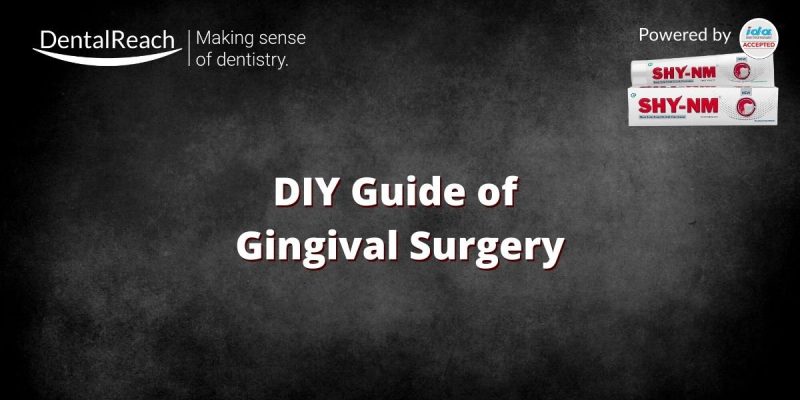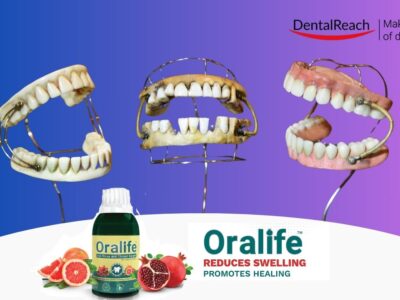Periodontal surgeries – in a nutshell
Periodontal surgery procedures are performed to prevent or correct anatomical, developmental, traumatic, or plaque induced defects of the gingiva, alveolar mucosa, and bone.

The procedure aims to treat the infected gum disease and any damage it may have caused by:
- regrowing damaged bones and tissues
- preventing tooth loss
- reducing gum gaps between teeth, known as black triangles
- reshaping the jaw hone to lower the risk for bacterial growth in bone crevices
- eliminating bacteria and infection

Pocket elimination has been the main objective of periodontal surgery.

When to perform periodontal surgery
The following findings may indicate the need for a surgical phase of therapy:
- Persistent inflammation in areas with moderate to deep pockets may require a surgical approach.
- In areas with shallow pockets or normal sulci, persistent inflammation may point to the presence of a mucogingival problem that needs a surgical solution.

- Areas with irregular bony contours and deep craters.

- Pockets on teeth in which a complete removal of root irritants is not considered clinically possible may call for surgery. Eg- Molar and premolar areas.

- In cases of furcation involvement of grade II or III, a surgical approach ensures the removal of irritants. Eg-root resection or hemisection also requires surgical intervention.

- Intrabony pockets on distal areas of last molars, frequently complicated by mucogingival problems, are usually unresponsive to nonsurgical methods.
When to not perform periodontal surgery
The following factors are to be considered before commencing periodontal surgery for long term pristine health of periodontium:
- Limited patient cooperation.
- Cardiovascular disease: Uncontrolled hypertension, Angina pectoris, Myocardial infarction, Anticoagulant therapy, Rheumatic endocarditis, congenital heart lesions, and heart vascular implants.
- Organ transplants.
- Blood disorders.
- Hormonal disorders: Uncontrolled diabetes, Adrenal dysfunction.
- Hematologic disorders: Multiple sclerosis and Parkinson’s disease, Epilepsy.
Here are my 10 personal tips for periodontal surgeries:
1) Procedural selection is crucial.
As a fresher, keep in mind the following factors before selecting the patient for perio-surgical procedures:
- Simplicity.
- Predictability.
- Efficiency.
- Mucogingival considerations.
- Underlying osseous topography.
- Anatomic and physical limitations (eg, reduced mouth opening, gagging, mental foramen).
- Age and systemic factors (eg, cardiac arrhythmias and murmurs, diabetes, history of radiation treatment, hypothyroidism, hyperthyroidism).
It is wiser to refer the case to a specialist in case you are highly unsure of any of the above.
2) Evaluate the biotype
Gingival biotype is the thickness of the gingiva in the faciopalatal dimension. It has a significant impact on the outcome of the restorative, regenerative and implant therapy.
Thick gingival tissues are relatively dense in appearance with a rather wide zone keratinized gingiva. On the other hand, a thin biotype is delicate and translucent, friable with a minimum zone of attached gingiva.
Methods of Assesment:

3) It all starts with a good incision
All incisions should be clear, smooth, and definite. Incision should be placed on firm tissues until you hit the bone to reflect mucoperiosteal flap.
Improper incision usually results in uneven ragged flap edges, which requires more healing time.



4) Consider keratinised tissues in flap design
All flaps should be designed for maximum use and retention of keratinized gingival tissue. This maintains a functional zone of attached keratinized gingiva post surgery and prevents needless secondary procedures.

5) Consider access and visibility in flap design
The flap design should allow for adequate access and visibility.
For treating localised defect, adjacent teeth must be involved too. For eg- treating a localised defect in canine & 1st molar, the adjacent teeth i.e. Lateral incisor and first premolar, plus 2nd premolar and 2nd molar should be involved.

6) Don’t be aggressive!
The flap design should prevent unnecessary bone exposure, which might result in dehiscence or fenestration formation later.

7) Primary > Secondary
Whenever possible, the surgical procedure should be carried out such that the postoperative healing takes place by primary intention, rather than secondary intention. What this means is- approximate the wound margins closely.

8) Don’t forget the base of the flap!
The base of a flap should be wider than the coronal aspect to allow for adequate vascularity.

9) Don’t leave any tissue tags
All the granulation tissue and tissue tags should be removed. A complete elimination allows rapid healing.

10) You have to suture your flaps well.
Adequate flap stabilization with sutures is necessary to prevent
- displacement
- unnecessary bleeding
- hematoma formation
- bone exposure
- possible infection.

Conclusion
The main objective of periodontal surgery is to obtain a healthy and functionally esthetic periodontium. The goal is to eliminate the pathologic changes in the pocket walls, to create a stable, easily maintainable state and if possible to promote periodontal regeneration. Surgery increase accessibility to root surface, making it possible to remove all irritants, reduce or eliminate pocket depth, and reshape soft and hard tissues to attain harmonious topography. However, periodontal surgery has its own indications and contraindications, so proper planning is needed before performing these procedures.
References
1. Axelsson P, Lindhe J. The significance of maintenance care in the treatment of periodontal disease. Journal of Clinical Periodontology 8, 281–294.
2. American Academy of Periodontology (AAP) (1996) Consensus report: Mucogingival therapy. Annals of Periodontology 1, 702–706.
3. Sato N. Clinical Periodontics and Prosthesis. Tokyo; Quintessence, 1992.
4. Knowles J W, Burgett F G, Nissle R R, Schick R A, Morrison E C, Ramfjord S P. Results of periodontal treatment related to pocket depth and attachment level. Eight years. Journal of Periodontology 50, 225–233.
5. Takei HH, Han TJ, Carranza Jr FA, et al. Flap technique for periodontal bone implants: the papilla preservation technique. J Periodontol 1985; 56: 204.




















Comments